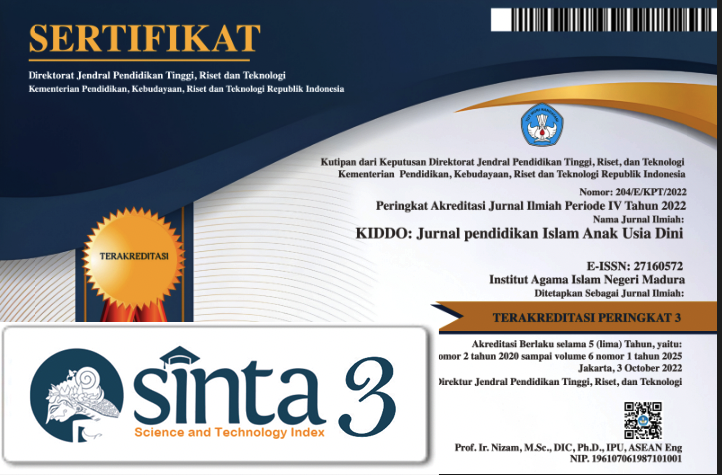Eksplorasi Korelasi Gender Sebagai Mediator dalam Keterlibatan Anak di Taman Kanak-Kanak
 Abstract views: 147
,
Abstract views: 147
,
 PDF downloads: 141
PDF downloads: 141
Abstract
This study aims to explore the correlation between gender as a mediator in children's engagement in kindergarten, using a quantitative approach with a correlational design. The study involved 70 children aged 5-6 years at Fadillah Amal 3 Kindergarten, Padang City, West Sumatra. The research instrument consisted of 42 questions, divided into 22 items related to engagement and 20 items related to gender, using a Likert scale with scores ranging from 1 to 5. Data collection was conducted through questionnaires filled out by classroom teachers. The results indicate a significant correlation between gender and children's engagement. The Pearson correlation test showed a coefficient value of 0.877, indicating a strong positive relationship between the gender variable and engagement. Further Paired Sample Test analysis revealed significant differences in children's engagement based on gender, with girls showing higher levels of engagement compared to boys. The determination coefficient test demonstrated that gender strongly contributes to children's engagement in kindergarten, with a coefficient value of 0.77 for the overall relationship, 0.788 for boys, and 0.53 for girls. These findings highlight the importance of considering gender differences when designing inclusive and effective learning strategies in early childhood education environments. This research provides valuable insights for educators and parents in enhancing children's engagement in kindergarten through gender-sensitive approaches.
Downloads
References
Aina, O., & Cameron, P. (2011). Why does gender matter? Counteracting stereotypes with young children. Dimensions of Early Childhood, 39(3), 11–19.https://hawthornefamilyplayschool.org/wpcontent/uploads/2013/10/whydoesgendermatter.pdf
Amelia K. Searle, Michael G. Sawyer, Lauren R. Miller-Lewis and Peter A. Baghurst. 2014. Prospective Associations between Children’s Preschool Emotional and Behavioral Problems and Kindergarten Classroom Engagement, and the Role of Gender; The Elementary School Journal, Vol. 114, No. 3, pp. 380-405
Blakemore, J. E. O., & Centers, R. E. (2005). Characteristics of boys’ and girls’ toys. Sex Roles, 53(9–10), 619–633. https://doi.org/10.1007/s11199-005- 7729-0
Børve, H. E., & Børve, E. (2017). Rooms with gender: Physical environment and play culture in kindergarten. Early Child Development and Care, 187(5–6), 1069–1081. https://doi.org/10.1080/03004430.2016.1223072
Brody, D.L., Scheiner, E.Y., Ari, D.B., Tzadok, Y., van der Aalsvoort, G.M., & Lepola, J. (2020). Measuring motivation in preschool children: a comparison of Israeli, Dutch, and Finnish children. Early Child Development and Care, 190, 150–160. https://doi.org/10.1080/ 03004430.2018.1459593
Cerna, L. et al. (2021), “Promoting inclusive education for diverse societies: A conceptual framework”, OECD Education Working Papers, No. 260, OECD Publishing, Paris, https://dx.doi.org/10.1787/94ab68c6-en.
Christia Spears Brown, Sharla D. Biefeld and Michelle J. Tam. 2020. Gender in Childhood; Cambridge University Press is part of the University of Cambridge. DOI: 10.1017/9781108874281
Dinella, L. M., & Weisgram, E. S. (2018). Gender-typing of children’s toys: Causes, consequences, and correlates. Sex Roles, 79(5–6), 253–259.
Eccles, J. S. (2016). Engagement: Where to next? Learning and Instruction, 43, 71–75. http://doi.org/10.1016/j.learninstruc.2016.02.003.
Fredricks, J. A., Blumenfeld, P. C., & Paris, A. H. (2004). School engagement: Potential of the concept, state of the evidence. Review of Educational Research, 74, 59–109.
Gagne, J. R., Miller, M. M., & Goldsmith, H. H. (2013). Early but modest gender differences in focal aspects of childhood temperament. Personality and Individual Differences, 55(2), 95–100. https://doi.org/10.1016/j.paid.2013.02.006
Haider Khan, Rani Gul & Murtaza Zeb. 2023. The Effect of Students’ Cognitive and Emotional Engagement on Students’ Academic Success and Academic Productivity; Journal of Social Sciences Review, 3(1), 322-334. https://doi.org/10.54183/jssr.v3i1.141
Havik, T., & Westergård, E. (2019). Do teachers matter? Students’ perceptions of classroom interactions and student engagement. Scandinavian Journal of Educational Research, 1–20. doi:10.1080/00313831.2019.1577754
Hoang, N., Holopainen, L., & Siekkinen, M. (2019). Children’s classroom engagement and disaffection in Vietnamese kindergartens. Educational Psychology, 39, 254–270. https://doi. org/10.1080/01443410.2018.1524854
Isabelle Archambault and Veronique Dupere. 2017. Joint trajectories of behavioral, affective, and cognitive engagement in elementary School: The Journal of Educational Research. VOL. 110, NO. 2, 188–198 http://dx.doi.org/10.1080/00220671.2015.1060931
Lam, S. et al. (2012). Do girls and boys perceive themselves as equally engaged in school? The results of an international study from 12 countries. Journal of School Psychology, 50(1), 77-94.
Li, Y., & Lerner, R. M. (2011). Trajectories of school engagement during adolescence: Implications for grades, depression, delinquency, and substance use. Developmental Psychology, 47, 233–247. http://dx.doi.org/ 10.1037/a0021307.21244162.
Luo, W., Hughes, J. N., Liew, J., & Kwok, O. (2009). Classifying academically at-risk first graders into engagement types: Association with long term achievement trajectories. The Elementary School Journal, 109, 380–405. http://dx.doi.org/10.1086/593939.
Martin, C. L., Fabes, R. A., Hanish, L., Leonard, S., & Dinella, L. M. (2011). Experienced and expected similarity to same-gender peers: Moving toward a comprehensive model of gender segregation. Sex Roles, 65(5–6), 421–434.
OECD. (2018). Investing in youth: Norway. Paris: OECD Publishing.
Renno, M. P., & Shutts, K. (2015). Children’s social category-based giving and its correlates: Expectations and preferences. Developmental Psychology, 51, 533–543. https:// doi.org/10.1037/a0038819.
Ruffing, S., Wach, F., Spinath, F. M., Brünken, R., & Karbach, J. (2015). Learning strategies and general cognitive ability as predictors of gender-specific academic achievement. Frontiers in Psychology, 6, Article ID 1238. doi:10.3389/ fpsyg.2015.01238
Rune Storli & Ellen Beate Hansen Sandseter. (2019). Children's play, well-being and involvement: how children play indoors and outdoors in Norwegian early childhood education and care institutions; International Journal of Play, VOL. 8, NO. 1, 65–78.
Sawyer, A. C., Miller-Lewis, L. R., Searle, A. K., Sawyer, M. G., & Lynch, J. W. (2015). Is greater improvement in early self-regulation associated with fewer behavioral problems later in childhood? Developmental Psychology, 51, 1740–1755. https://psycnet.apa.org/doi/10.1037/ a0039829.
Sirunyan, A. M., Tumasyan, A., Adam, W., Ambrogi, F., Asilar, E., Bergauer, T., . . . Del Valle, A. E. J. T. E. P. J. C. (2020). Extraction and validation of a new set of CMS PYTHIA 8 tunes from underlying-event measurements. 80, 1-47.
Thompson, A. E., & Voyer, D. (2014). Sex differences in the ability to recognise non-verbal displays of emotion: A meta-analysis. Cognition & Emotion, 28(7), 1164–1195. https://doi.org/10. 1080/02699931.2013.875889
Trawick-Smith, J., Wolff, J. Koschel, M. and Vallarelli, A. (2015) ‘Effects of Toys on the Play Quality of Preschool Children: Influence of Gender, Ethnicity, and Socioeconomic Status’ Early Childhood Education. 43(4), pp.249–256.
Vecchione, M., Alessandri, G., & Marsicano, G. (2014). Academic motivation predicts educational attainment: Does gender make a difference? Learning and Individual Differences, 32, 124–131. doi:10.1016/j.lindif.2014.01.003
Veríssimo, N. V., Mussagy, C. U., Oshiro, A. A.,Mendonça, C. M. N., de Carvalho Santos-Ebinuma, V., Pessoa, A., . . . Pereira, J. F. B. J. G. C. (2021). From green to blue economy: Marine biorefineries for a sustainable ocean- based economy. 23(23), 9377-9400. https://doi.org/10.1039/d1gc03191k
Wang, M.-T., & Eccles, J. S. (2012). Adolescent behavioral, emotional, and cognitive engagement trajectories in school and their differential relations to educational success. Journal of Research on Adolescence, 22, 31–39. http://dx.doi.org/10.1111/j.1532-7795.2011.00753.x
Wei Hong, Rui Zhen, Ru-De Liu, Ming-Te Wang, Yi Ding & Jia Wang. 2020. The longitudinal linkages among Chinese children’s behavioural, cognitive, and emotional engagement within a mathematics context; An International Journal of Experimental Educational Psychology, DOI: 10.1080/01443410.2020.1719981
Weisgram, E. S., & Dinella, L. M. (2018). Gender typing of children’s toys: How early play experiences impact development. Washington, DC: American Psychological Association.
Zeng, H., Xu, C., Fan, J., Tang, Y., Deng, Q., Zhang, W., & Long, X. (2020). Antibodies in infants born to mothers with COVID-19 pneumonia. JAMA. https://doi.org/10.1001/ja ma.2020.4861
Zhou, G., Gul, R., & Tufail, M. (2022). Does servant leadership stimulate work engagement? The moderating role of trust in the leader. Frontiers in Psychology, 13. https://doi.org/10.3389/fpsyg. 2022.925732
Copyright (c) 2024 ilham sakri alfaregi ilham sakri alfaregi

This work is licensed under a Creative Commons Attribution 4.0 International License.
-
The journal operates an Open Access policy under a Creative Commons 4.0 International license. The terms of the license are:
Share— copy and redistribute the material in any medium or format
Adapt— remix, transform, and build upon the material for any purpose, even commercially.
1. Authors retain copyright and grant the journal right of first publication with the work simultaneously licensed under a Creative Commons License.that allows others to share the work with an acknowledgement of the work’s authorship and initial publication in this journal
2. Authors are permitted and encouraged to post their work online (e.g., in institutional repositories or on their website) prior to and during the submission process, as it can lead to productive exchanges, as well as earlier and greater citation of published work (See The Effect of Open Access).
Jurnal Kiddo is licensed under a Creative Commons
n Access).














